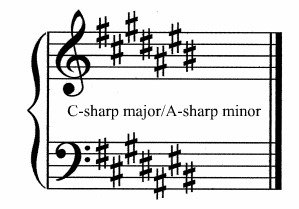Buy a Keyboard
※ Download: D sharp major key signature
Further such raising adds sharps as described above. Although a key signature may be written using any combination of sharp and flat symbols, the most common series of thirteen homogeneous key signatures—ranging from six flats to six sharps, with each successive flat or sharp placed on the , respectively, the previous one—is assumed in much of this article. Later on, this use of a key signature that is theoretically incorrect for a piece as a whole or a self-contained section of a piece became less common in contrast to brief passages within a piece, which, as they modulate from key to key often temporarily disagree with the key signature ; but it can be found at least as late as one of Beethoven's very late piano sonatas.

The B is flatted so that the scale follows the same W W H W W W H pattern. Likewise, if you know the pattern for any other scale, you can create them, too. Accessed 17 March 2010.

Key Signatures - Flats The same holds for the flats, except that we go counterclockwise along the Circle of Fifths, and flats go down by a fifth. Flats are always added in this order: B, E, A, D, G, C, F.

What are the basic chords in the key of D major? The notes of the D major scale are D E F G A B C. The chords in the key of D major are named after these seven notes. Also, the notes of each chord are limited to these notes. The pattern for naming major chords in every key is Major Minor Minor Major Major Minor Diminished. To learn more about chords by key what chords are in what key and why , check out my book,. The triads in this key are D major, E minor, F minor, G major, A major, B minor, and C diminished. The four note chords are D major seventh, E minor seventh, F minor seventh, G major seventh, A dominant seventh, B minor seventh, and C minor seventh flat five. In terms of the keys played on your instrument, C m7b5 is the same as C half diminished. Roman numerals for major chords are capitalized while minor and diminished chords are lower case. So what notes do these chords consist of? E minor seventh consists of the notes, E — G — B — D. F minor seventh contains the notes, F — A — C — E. G major seventh contains the notes, G — B — D — F. A dominant seventh contains the notes, A — C — E — G. B minor seventh consists of the note, B — D — F — A. The D major scale has two sharps. These sharps are C C sharp and F F sharp. Here is a diagram showing the D major scale on piano.
Roman numerals for major chords are capitalized while minor and diminished chords are lower case. Sharps are added in the reverse order: F, C, G, D, A, E, B. So what notes do these chords consist of. Meanwhile, the E horns would have parts written with a. You can view our here. Later on, this use of a key signature that is theoretically incorrect for a piece as a whole or a self-contained section of a piece became less common in contrast to brief passages within a piece, which, as they modulate from key to key often temporarily disagree with the key signature ; but it can be found at least as late as one of Beethoven's very late piano sonatas. The key signature may be changed at any time in a piece, usually at the beginning of asimply by notating the new signature, although if the new signature has no sharps or flats, a signature of naturals, d sharp major key signature shown, is needed to cancel the preceding signature. They are convenient principally for or music. There are half steps between the second and third and the fifth and sixth degrees; whole steps exist between all other steps. Learning Outcomes: By the end of this module, you should be able to 1 describe the diatonic set and understand how it is used to create major and minor scales, 2 sing major and minor using solfeggio solfege syllables, 3 explain d sharp major key signature difference between natural, harmonic, and melodic minor, 4 spell major and minor scales starting on any note using accidentals in treble and bass clef, and 5 spell parallel and relative major and minor scales. Remember that sharps and flats affect names.



